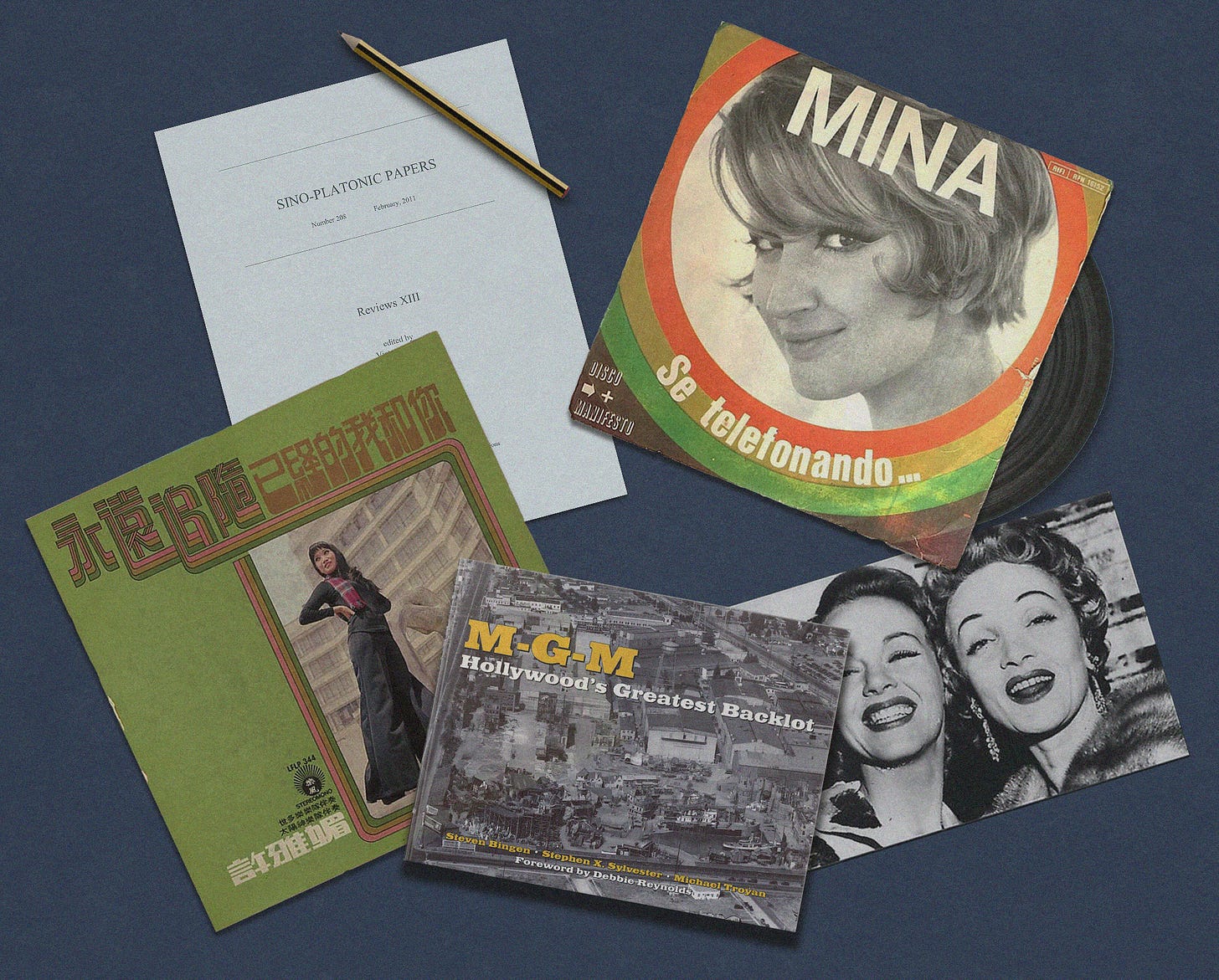Eclectic Letters #9 — Ella Dorn
Italian music videos shot by Fellini's set designer, a long-lost Malaysian pop star, the Sino-Platonic Papers, abandoned Hollywood film sets, and an intimate biography of Marlene Dietrich.
Primordial Italian music videos
If you are a Fellini fan, you should get on this ASAP — Italian costume and set designer Piero Gherardi won Oscars for his work on 8 ½ and La Dolce Vita, but few in the Anglosphere know that he also regularly directed TV spots for the singer Mina, who remains a household name in Italy. There are no grand tableaux or appearances from the Trevi Fountain, but there are lots of fantastic shots of brutalist architecture and Aubrey Beardsley-esque costumes. I was fascinated to see how the Felliniesque aesthetic translated over to short-form, even pre-MTV — this was the age of the relatively-simple Scopitone, before directors gained renown for doing music videos (I also recommend this Scopitone archive).
Ni Shi Shei by Xu Yamei
I did a degree in Mandarin Chinese but the main way I’ve used the language after graduating is to look for 70s music from Taiwan, Hong Kong and Singapore. This is my favourite find ever — a haunting, Morricone-esque track from Malaysian singer Xu Yamei. Some Mandarin pop stars from the period retain their fame (also worth checking out: Ouyang Feifei, Yang Hsiao-ping, You Ya, Louise Tsuei), but there is virtually zero biographical information or discussion about Xu online. This makes this specific song even better — it’s literally called “Who Are You” and it’s about a lover who comes into her life “like a gust of wind” before “leaving, never to return.”
Sino-Platonic Papers
Occasionally the coolest things ever come out through Sinologist Victor Mair’s Sino-Platonic Papers, an open-source home for really exciting scholarship that, “because of its unconventional or controversial nature, might otherwise go unpublished.” The papers are mostly on dynastic China, but they sometimes cover cross-cultural links to the West and Near East. Of interest: Brian R. Pellar finds a link between the Phoenician alphabet, the Eastern and Western zodiacs, and the Chinese ganzhi dating system (it’s all to do with the growth cycle of a certain kind of wheat); Lucas Christopolous looks for Zeus in Gansu; Mark A. Riddle (a Pynchonesque name) traces Japan’s Rising Sun back to Central Asia.
Phantom of the Backlots
Most of the best classic movie writing today is done on WordPress blogs. My favourite is by Donnie Norden, a long-time California resident who now writes as Phantom of the Backlots — he is an enthusiast of what he calls “motion picture archaeology,” and shares his experiences of breaking into abandoned Hollywood film sets. (When I read this book about the old MGM backlot in Culver City I couldn’t help but imagine how cool it would have been to dig it all up thousands of years into the future, like a cineaste Howard Carter). Among other archaeological feats, Norden has pinned down the location of the columns from the original Gone with the Wind plantation and located a dressing room once occupied by Silent Era star Marion Davies (someone was using it as a garden shed). There should be a film about him!
Marlene Dietrich by Maria Riva
Maria Riva happens to be the daughter of 1930s Hollywood superstar Marlene Dietrich, but she is also a fantastic, perceptive writer. We “get” the absurdity of the 1930s Fordist studio system more easily from her child’s-eye-view than from the work of any novelist who has tried to cover it. This tell-all about her mother’s life and her own strange upbringing is my favourite Hollywood memoir and also probably my favourite book. Reading it is a bit like reading an 800-page gossip magazine in which all the gossip has been made up by Christopher Isherwood. (The moral: sometimes nepotism actually is good?)
There is something completely outrageous at almost every corner of the memoir, which could easily have been made into an actual film by Dietrich’s frequent baroque collaborator, Josef von Sternberg — Dietrich wore a near-identical version of Bjork’s famous swan dress at a fancy dress party in 1935, Hermes designed a new handbag specifically to help her carry bread into restaurants, she was obsessed with the Kennedys and also with Eric Maria Remarque and also with the inventor of penicillin (he sent her the first strain under glass — she wanted a signed photo).
This book is technically about how Dietrich was an unfaithful wife and unfit mother — Riva, babied and ignored for her entire childhood, wrote it as a sort of revenge. But the effect is subtle, and it’ll still make you want to watch the Dietrich-von Sternberg collabs, which represent the exact sort of fussy and self-important maximalism we ought to bring back to the screen — start with The Scarlet Empress, their highly inaccurate biopic of Catherine the Great. It’s featured in Horace McCoy’s cult novel They Shoot Horses, Don’t They? — his lead characters participate in a weeks-long danceathon after failing to make the cut as extras for Empress. We learn from Riva’s book that a horse probably was shot on the set of the film either way!
Ella Dorn is a London-based writer and commentator with bylines in the New Statesman, the Spectator, and the Guardian. She runs the Substack Fairyland! and is currently working on her first novel. You can find her website here.







